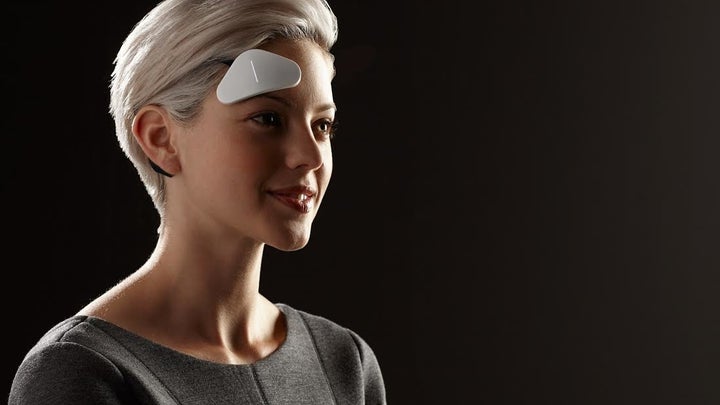What if you could zap your brain into a state of calm or energy with only the push of a button?
It may sound like the stuff of sci-fi, but it's now the promise of a new class of tech wearables created by teams of Silicon Valley entrepreneurs and neuroscientists.
Several devices have come onto the market claiming to use brain stimulation to alter an individual's mental state. One of the latest is Thync Vibes ($299), a stick-on device that delivers low-grade electrical pulses ("vibes") into the scalp to cause a change in automatic nervous system activity.
How does it actually work?
Those who are brave enough to try it will stick a small triangular device onto the side of the forehead and attach another small strip to the back of the neck or behind the ear. Using the Thync iPhone app, you adjust the intensity and duration of the session, which can range from 5 to 20 minutes. During that time, pulses of electricity will activate either your parasympathetic nervous system (the "rest and digest" system, which slows the heart rate) or your sympathetic nervous system (responsible for the "fight or flight" response), depending on whether you choose the "calm" or "energy" setting.

Thync, which is led by CEO Isy Goldwasser and neuroscientist/chief scientific officer Jamie Tyler, aims to "bring neuroscience to everyday people." So far, the company has received more than $13 million from investors.
"Most people, especially in New York, could use an 'off' button at night," Goldwasser said. "It helps you to really relax, de-stress and heal from the go-go-go of the day."
The prospect of being able to shift one's mood with the touch of a button is pretty tantalizing. But is it too good to be true?
A new frontier
The Thync device was given an exemption by the Food and Drug Administration, as it is being marketed for lifestyle rather than medical uses.
Thync has conducted its own research on more than 4,000 participants, and has funded research with City College of New York to test its device. In a trial last year, 100 participants tried out the Vibes, which was found to be effective in producing feelings of calm. The researchers noted that the device did not seem to pose any significant health risk to consumers.
The Thync team claims that you could use the device multiple times a day with the only risk being the possible irritation of the skin where it's attached.
When it comes to brain stimulation devices more broadly, there are a few things to bear in mind.
Moreover, electrical brain stimulation has been around for decades. Today, promising research is being conducted using transcranial direct current stimulation (tDCS) -- which uses electrodes to administer low-grade electrical pulses that stimulate different parts of the brain -- to treat neurological and mental health problems ranging from tinnitus to depression.
But that's under medical supervision. Some neuroscientists are becoming concerned about the DIY use of brain stimulation. They worry about the lack of regulation of and research into the long-term safety of such wearables.
University of Oxford ethicist Julian Savulescu told The Guardian in December, “This is the wild West for cognitive enhancing devices."
"We are still looking at the tip of the iceberg," Dr. Roi Cohen Kadosh, a professor of cognitive neuroscience at Oxford, said to HuffPost. "We still do not have good understanding of the potential side effects -- especially not the long-term effect of tDCS, and especially not for those that will be used at home for months."
In 2013, when an earlier brain stimulation device that targeted gamers hit the market, an editorial in the prestigious science journal Nature raised concerns about "amateurish meddling with tDCS," while psychologist Nick Davis issued a "plea for extreme caution" in an opinion piece published in Frontiers in Human Neuroscience. A research team at Oxford, which includes Cohen Kadosh, has also launched a campaign calling for regulation of the devices.
When HuffPost spoke to Dr. Flavio Frohlich, a neuroscientist and biomedical engineer at the University of North Carolina, about his research using brain stimulation to boost creativity and ease depression earlier this year, he was enthusiastic about the possibilities that tDCS opened up for treating psychiatric illness. He was less jazzed, however, about the marketing of brain stimulation products to consumers.
Frohlich said that he was "deeply worried" about their use, particularly because scientists don't yet understand how the devices interact with the nervous system and what the potential consequences for brain function might be.
"I would absolutely not recommend these devices," he said. "I find it dangerous to market brain stimulation devices that can potentially alter brain function without having studied in detail the actual effects."
Frohlich cited several studies, including one conducted in his own lab, which have found that brain stimulation can actually have a negative impact on cognitive functioning.
He also expressed concern that the marketing of brain stimulation as a DIY method could make it harder for the technology to be taken seriously in clinical contexts.
"Non-invasive brain stimulation has a great future for therapeutic applications under medical supervision," he said. "Recasting it as a lifestyle tool could jeopardize this future."
Neuroscientist Vince Clark of the University of New Mexico was less negative. He suggested that brain stimulation, if used carefully, could be a safer alternative to drugs and alcohol as a means of altering an individual's mental state, particularly for those struggling with mental illness.
"That risk will never be zero, we can never be absolutely certain, but so far it looks much safer when used within limits," Clark said. "This risk makes more sense in people with brain or mental illness, who really need help, rather than someone who just wants to change how they feel."
Good vibrations
I was recently given the opportunity to try out the Thync Vibes.
Goldwasser conceives of it as an alternative to a morning espresso or an afternoon nap -- a simple fix for when you're feeling sluggish or stressed-out. Been there, felt that.
The device did seem to work on some level. For 15 minutes, I experienced a light pressure on the side of my forehead while the electrodes delivered pulses. Toward the end of the session and for about an hour afterward, my brain was definitely down a notch. However, I wouldn't describe the feeling as zen so much as vaguely stoned. This is apparently not unusual, as one of the company's publicity reps, Mark de la Vina, told me that it makes a small percentage of users feel high. I felt a pleasant, light floatiness and noticed myself typing and speaking more slowly.
The sensation was something I could definitely get used to -- although I won't be swapping out my meditation practice for a vibe session anytime soon.
"People seek to relax ... in different ways," said Dr. Judy Iles, a University of British Columbia neuroethicist. "But why it is better or safer than exercise, meditation or fresh air or other healthy lifestyle behaviors is not evident."
The bottom line? Early adopters are essentially part of an experiment. Casual users might replace the evening cocktail with an occasional zap, but until more research is done, you'd be wise to think twice before replacing your morning coffee with a jolt to the head.
CORRECTION: An earlier version of this story stated that Thync stimulates the central nervous system, when in fact it triggers changes in the automatic nervous system. The article has been updated.
